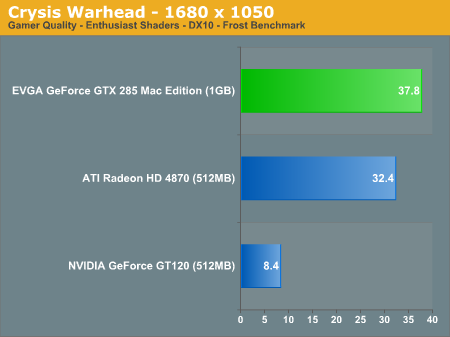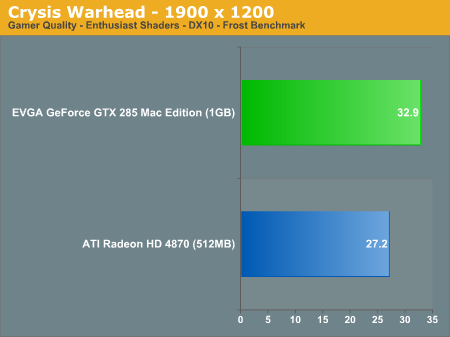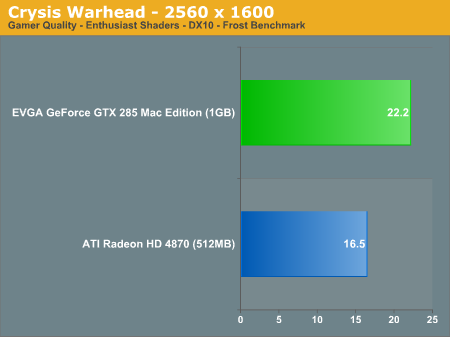EVGA's GeForce GTX 285 Mac Edition: The Best for OS X?
by Anand Lal Shimpi on July 17, 2009 7:00 PM EST- Posted in
- GPUs
Gaming Under Windows
To Apple’s credit, the Radeon HD 4870 is a respectable GPU option on the Mac Pro. My only complaints there are with regards to price and memory size. Apple charges $200 for the upgrade as a BTO option while configuring your Mac Pro, but $349 if you want to buy it later. To make matters worse, the card only has 512MB of memory which is better than the 128MB cards that Apple used to ship but still too small for an OS that makes good use of video memory.
While there are a few respectable gaming titles on the Mac, most gamers will want to boot into Windows for all gaming. You could keep a second (PC) video card in your Mac Pro and just swap monitor outputs when you want to game or snag one of these EVGA GTX 285s. As a gaming card under Windows, it’ll be the fastest you can get through official channels.
I ran our standard Crysis Warhead tests on the Mac Pro to show how the GTX 285 and Radeon HD 4870 stack up:



The performance advantage ranges from 17% at 1680 x 1050 to 35% at 2560 x 1600.
I was curious to see how my 2.93GHz Mac Pro stacked up to our 3.2GHz Core i7 GPU testbed so I compared the results:
| Crysis Warhead | 1680 x 1050 | 1900 x 1200 | 2560 x 1600 |
| Apple Mac Pro 2009 - 2 x 2.93GHz Xeon X5570 | 37.8 fps | 32.9 fps | 22.2 fps |
| AnandTech GPU Testbed - 1 x Core i7 965 (3.20GHz) | 38.5 fps | 32.8 fps | 22.4 fps |
It looks like the numbers are pretty comparable, so if you’d like to see a more detailed performance comparison between the Radeon HD 4870 and the GTX 285 feel free to read through any of our recent GPU articles. The numbers should apply to the Mac Pro just fine.










48 Comments
View All Comments
bupkus - Saturday, July 18, 2009 - link
For so very long linux never could claim itself a good platform for games. So I'm thinking, admittedly quite wishfully, that the OS X's linux roots could provide a trail for drivers in OS X to become useful in linux.What say you experts on this matter?
erple2 - Saturday, July 18, 2009 - link
OSX isn't based on Linux. It's based on a BSD flavor. I'm not sure if it's NetBSD or OpenBSD (I think NetBSD). Which is very different from Linux.Kurotetsu - Tuesday, July 21, 2009 - link
Well, according to Wiki (which means you should take it with some salt), it was both:Mac OS X is based upon the Mach kernel.[8] Certain parts from FreeBSD's and NetBSD's implementation of Unix were incorporated in Nextstep, the core of Mac OS X. Nextstep was the object-oriented operating system developed by Steve Jobs' company NeXT after he left Apple in 1985.[9]
http://en.wikipedia.org/wiki/Mac_OS_X">http://en.wikipedia.org/wiki/Mac_OS_X
sprockkets - Tuesday, July 21, 2009 - link
Yes, this is true. The BSD part is just for POSIX compliance. Even though OSX is certified UNIX, Apple saying it is UNIX stable is a bit disingenuous, as the part of the kernel doing all the work is all Apple, not UNIX or BSD.8steve8 - Friday, July 17, 2009 - link
means can't connect to the LED 24" display apple makes.weird.
Natfly - Saturday, July 18, 2009 - link
I would think a standard dvi -> mini-displayport adapter would work, right?http://www.monoprice.com/products/product.asp?c_id...">http://www.monoprice.com/products/produ...2&p_...
BrianMCan - Monday, July 20, 2009 - link
no, that is to connect a DVI monitor to mini-displayport computer.to go the other way it would have DVI male, to mini-displayport female.
Demon-Xanth - Friday, July 17, 2009 - link
...the markup on those cables is the most I've seen outside of audiophile or specialty cables.
Connectors:
4x Molex 45559-0002 $0.30ea, $0.14/ea in quantities of 5000
24x Molex 44476-1111 $0.12ea, $0.05/ea in quantities of 4000
12' 18AWG stranded wire (assuming the cables are 12") $38/100 foot spool, $145 for 1000'
(prices from Mouser, distributors may be much lower)
Low quantity cost: About $8 for the pair.
Higher quantity cost: About $3 for the pair.
Admittedly, the crimp tool itself runs about $320, so given the $52 profit margin, it should take about 7 sets to end up in the black.
rpmurray - Tuesday, July 21, 2009 - link
I'd go with the higher quality pair, according to you they're $5 cheaper then the low qualityDemon-Xanth - Thursday, July 23, 2009 - link
Quantity, not quality.The parts are $8 for two if you built one set. $3 for two if you build 1000 sets.